Effective Strategies to Enhance Student Reading and Writing Abilities
VerifiedAdded on 2022/12/27
|10
|2944
|2
Report
AI Summary
This report explores strategies for students to enhance their reading and writing abilities. It begins by outlining various reading strategies, including predicting content, understanding the gist, skimming, scanning, using signposting language, reading for detail, and annotating/highlighting text. The report then provides suggestions for improving writing quality, such as using correct materials, practicing critical thinking, proofreading, using paraphrasing and referencing effectively, understanding the purpose of writing, planning a content structure, using appropriate language, avoiding over-explanation and ambiguous words, and utilizing feedback. The report emphasizes the importance of these strategies for academic success and provides practical guidance for students to improve their skills in both reading and writing, contributing to their overall learning and achievement.
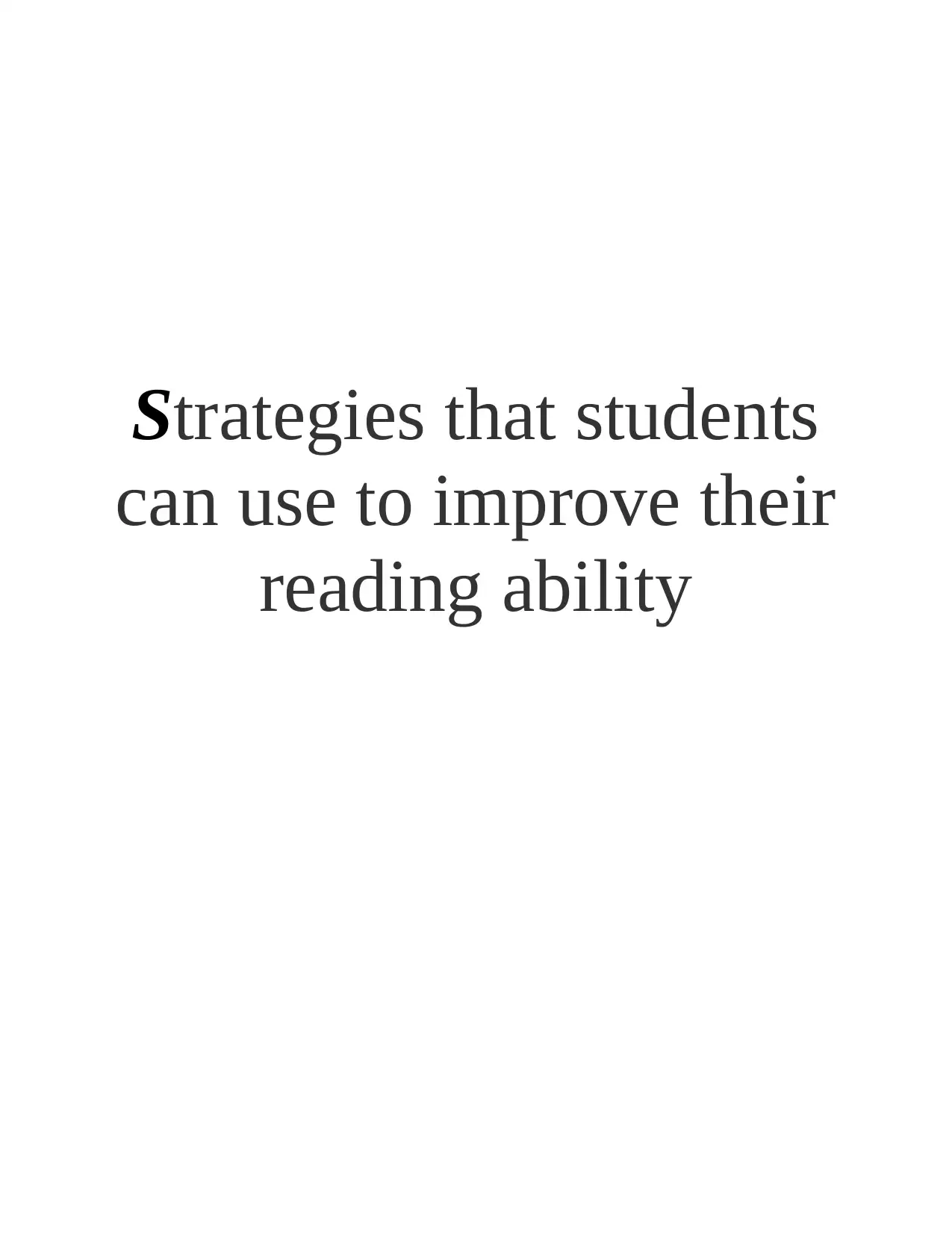
Strategies that students
can use to improve their
reading ability
can use to improve their
reading ability
Paraphrase This Document
Need a fresh take? Get an instant paraphrase of this document with our AI Paraphraser
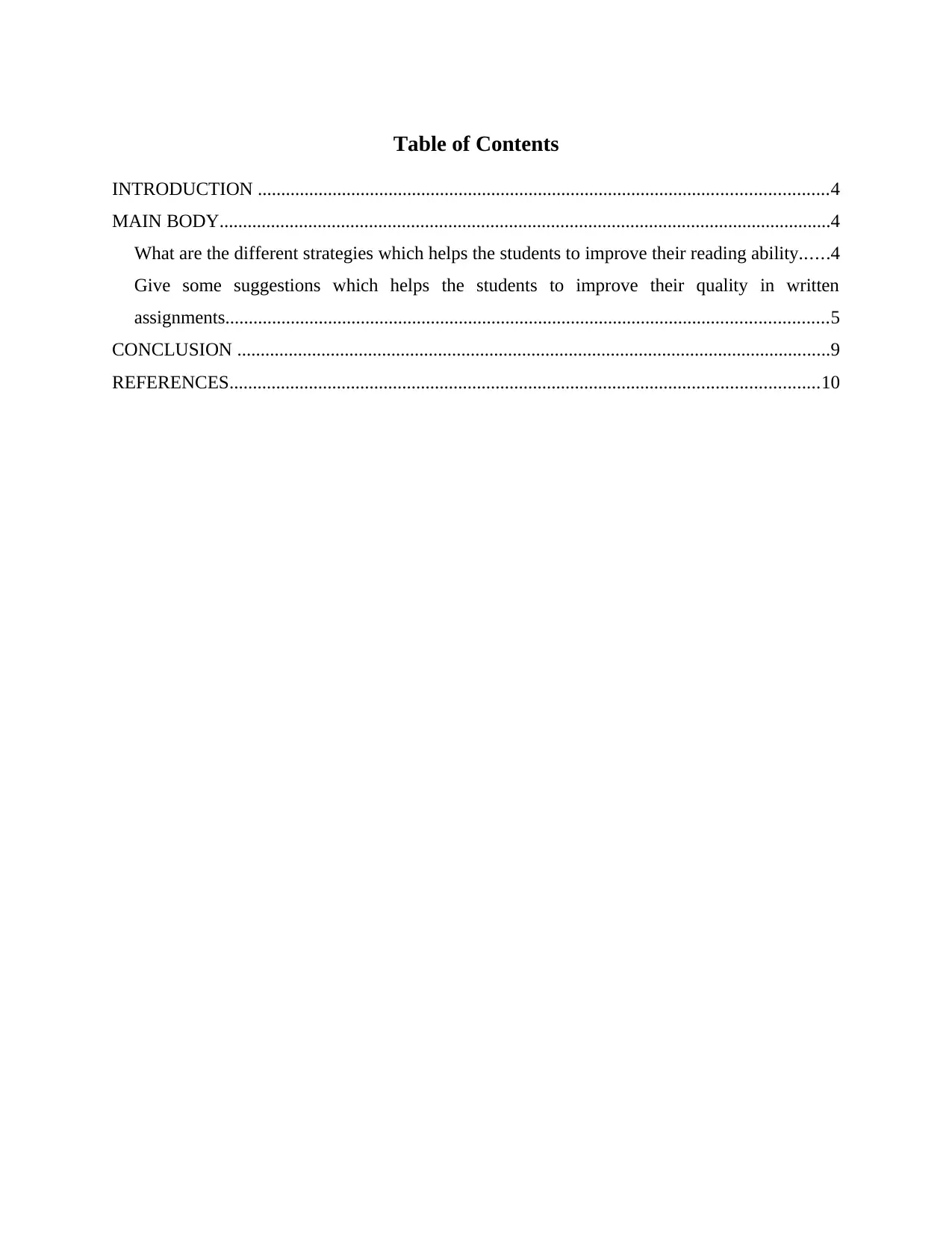
Table of Contents
INTRODUCTION ..........................................................................................................................4
MAIN BODY...................................................................................................................................4
What are the different strategies which helps the students to improve their reading ability......4
Give some suggestions which helps the students to improve their quality in written
assignments.................................................................................................................................5
CONCLUSION ...............................................................................................................................9
REFERENCES..............................................................................................................................10
INTRODUCTION ..........................................................................................................................4
MAIN BODY...................................................................................................................................4
What are the different strategies which helps the students to improve their reading ability......4
Give some suggestions which helps the students to improve their quality in written
assignments.................................................................................................................................5
CONCLUSION ...............................................................................................................................9
REFERENCES..............................................................................................................................10
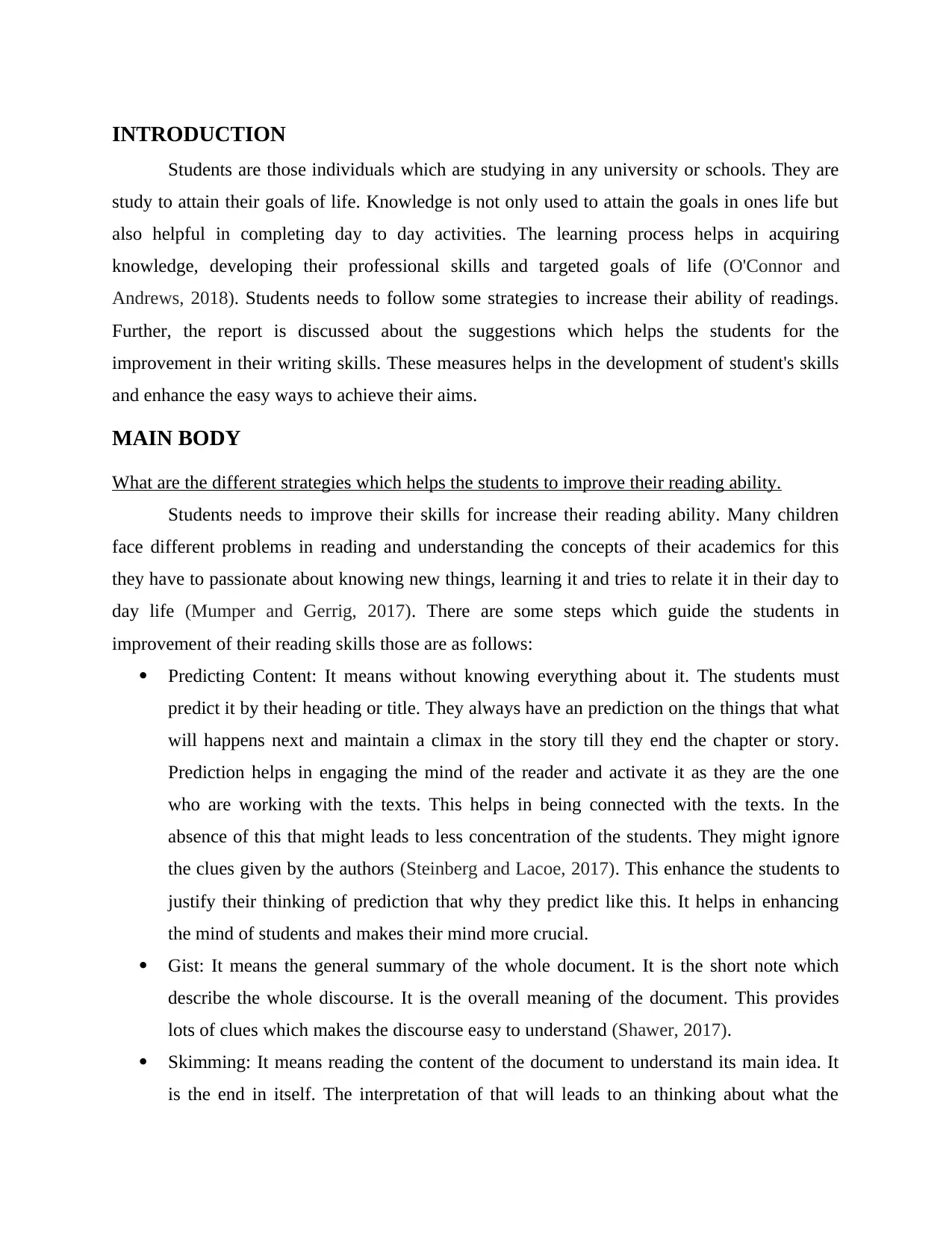
INTRODUCTION
Students are those individuals which are studying in any university or schools. They are
study to attain their goals of life. Knowledge is not only used to attain the goals in ones life but
also helpful in completing day to day activities. The learning process helps in acquiring
knowledge, developing their professional skills and targeted goals of life (O'Connor and
Andrews, 2018). Students needs to follow some strategies to increase their ability of readings.
Further, the report is discussed about the suggestions which helps the students for the
improvement in their writing skills. These measures helps in the development of student's skills
and enhance the easy ways to achieve their aims.
MAIN BODY
What are the different strategies which helps the students to improve their reading ability.
Students needs to improve their skills for increase their reading ability. Many children
face different problems in reading and understanding the concepts of their academics for this
they have to passionate about knowing new things, learning it and tries to relate it in their day to
day life (Mumper and Gerrig, 2017). There are some steps which guide the students in
improvement of their reading skills those are as follows:
Predicting Content: It means without knowing everything about it. The students must
predict it by their heading or title. They always have an prediction on the things that what
will happens next and maintain a climax in the story till they end the chapter or story.
Prediction helps in engaging the mind of the reader and activate it as they are the one
who are working with the texts. This helps in being connected with the texts. In the
absence of this that might leads to less concentration of the students. They might ignore
the clues given by the authors (Steinberg and Lacoe, 2017). This enhance the students to
justify their thinking of prediction that why they predict like this. It helps in enhancing
the mind of students and makes their mind more crucial.
Gist: It means the general summary of the whole document. It is the short note which
describe the whole discourse. It is the overall meaning of the document. This provides
lots of clues which makes the discourse easy to understand (Shawer, 2017).
Skimming: It means reading the content of the document to understand its main idea. It
is the end in itself. The interpretation of that will leads to an thinking about what the
Students are those individuals which are studying in any university or schools. They are
study to attain their goals of life. Knowledge is not only used to attain the goals in ones life but
also helpful in completing day to day activities. The learning process helps in acquiring
knowledge, developing their professional skills and targeted goals of life (O'Connor and
Andrews, 2018). Students needs to follow some strategies to increase their ability of readings.
Further, the report is discussed about the suggestions which helps the students for the
improvement in their writing skills. These measures helps in the development of student's skills
and enhance the easy ways to achieve their aims.
MAIN BODY
What are the different strategies which helps the students to improve their reading ability.
Students needs to improve their skills for increase their reading ability. Many children
face different problems in reading and understanding the concepts of their academics for this
they have to passionate about knowing new things, learning it and tries to relate it in their day to
day life (Mumper and Gerrig, 2017). There are some steps which guide the students in
improvement of their reading skills those are as follows:
Predicting Content: It means without knowing everything about it. The students must
predict it by their heading or title. They always have an prediction on the things that what
will happens next and maintain a climax in the story till they end the chapter or story.
Prediction helps in engaging the mind of the reader and activate it as they are the one
who are working with the texts. This helps in being connected with the texts. In the
absence of this that might leads to less concentration of the students. They might ignore
the clues given by the authors (Steinberg and Lacoe, 2017). This enhance the students to
justify their thinking of prediction that why they predict like this. It helps in enhancing
the mind of students and makes their mind more crucial.
Gist: It means the general summary of the whole document. It is the short note which
describe the whole discourse. It is the overall meaning of the document. This provides
lots of clues which makes the discourse easy to understand (Shawer, 2017).
Skimming: It means reading the content of the document to understand its main idea. It
is the end in itself. The interpretation of that will leads to an thinking about what the
⊘ This is a preview!⊘
Do you want full access?
Subscribe today to unlock all pages.

Trusted by 1+ million students worldwide
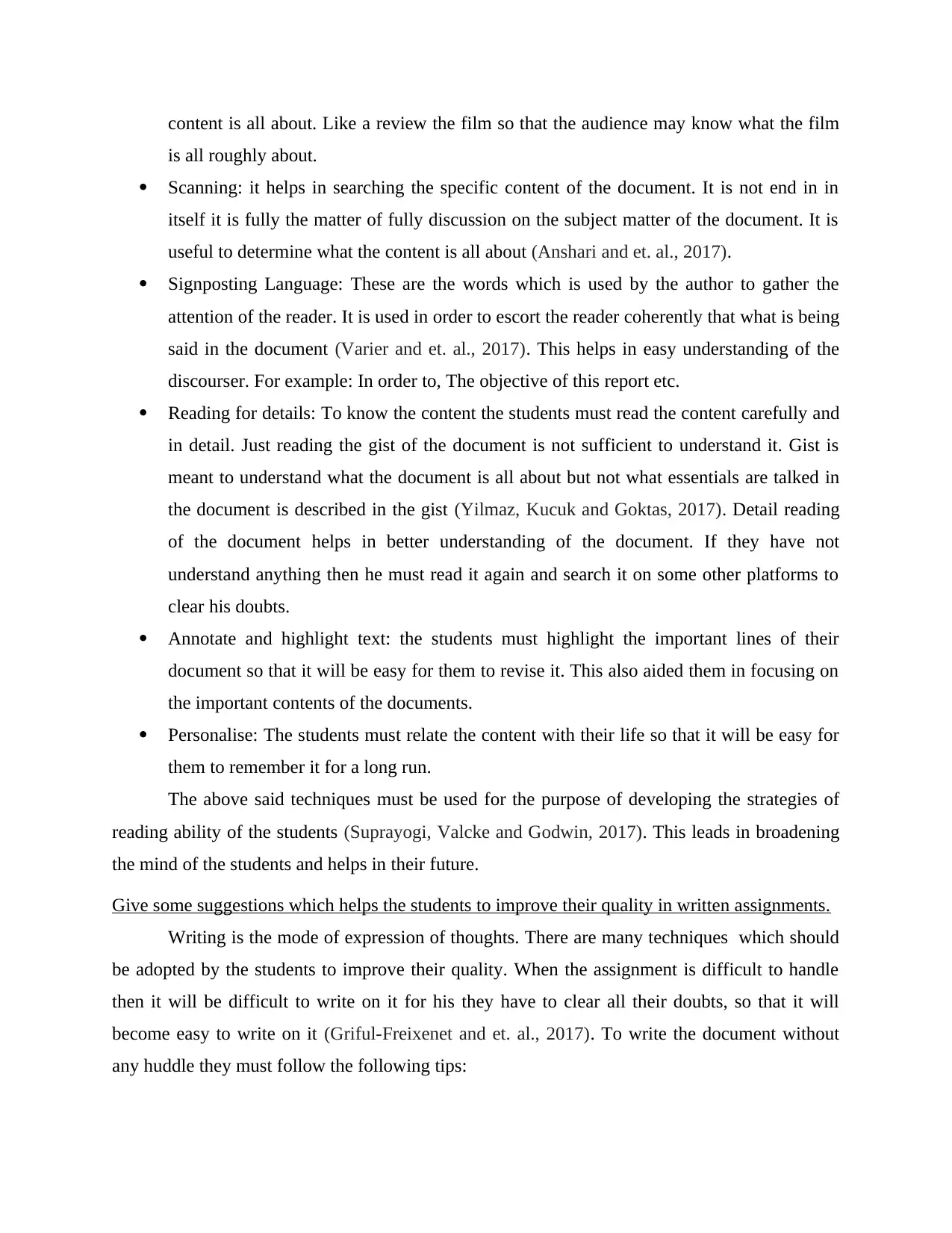
content is all about. Like a review the film so that the audience may know what the film
is all roughly about.
Scanning: it helps in searching the specific content of the document. It is not end in in
itself it is fully the matter of fully discussion on the subject matter of the document. It is
useful to determine what the content is all about (Anshari and et. al., 2017).
Signposting Language: These are the words which is used by the author to gather the
attention of the reader. It is used in order to escort the reader coherently that what is being
said in the document (Varier and et. al., 2017). This helps in easy understanding of the
discourser. For example: In order to, The objective of this report etc.
Reading for details: To know the content the students must read the content carefully and
in detail. Just reading the gist of the document is not sufficient to understand it. Gist is
meant to understand what the document is all about but not what essentials are talked in
the document is described in the gist (Yilmaz, Kucuk and Goktas, 2017). Detail reading
of the document helps in better understanding of the document. If they have not
understand anything then he must read it again and search it on some other platforms to
clear his doubts.
Annotate and highlight text: the students must highlight the important lines of their
document so that it will be easy for them to revise it. This also aided them in focusing on
the important contents of the documents.
Personalise: The students must relate the content with their life so that it will be easy for
them to remember it for a long run.
The above said techniques must be used for the purpose of developing the strategies of
reading ability of the students (Suprayogi, Valcke and Godwin, 2017). This leads in broadening
the mind of the students and helps in their future.
Give some suggestions which helps the students to improve their quality in written assignments.
Writing is the mode of expression of thoughts. There are many techniques which should
be adopted by the students to improve their quality. When the assignment is difficult to handle
then it will be difficult to write on it for his they have to clear all their doubts, so that it will
become easy to write on it (Griful-Freixenet and et. al., 2017). To write the document without
any huddle they must follow the following tips:
is all roughly about.
Scanning: it helps in searching the specific content of the document. It is not end in in
itself it is fully the matter of fully discussion on the subject matter of the document. It is
useful to determine what the content is all about (Anshari and et. al., 2017).
Signposting Language: These are the words which is used by the author to gather the
attention of the reader. It is used in order to escort the reader coherently that what is being
said in the document (Varier and et. al., 2017). This helps in easy understanding of the
discourser. For example: In order to, The objective of this report etc.
Reading for details: To know the content the students must read the content carefully and
in detail. Just reading the gist of the document is not sufficient to understand it. Gist is
meant to understand what the document is all about but not what essentials are talked in
the document is described in the gist (Yilmaz, Kucuk and Goktas, 2017). Detail reading
of the document helps in better understanding of the document. If they have not
understand anything then he must read it again and search it on some other platforms to
clear his doubts.
Annotate and highlight text: the students must highlight the important lines of their
document so that it will be easy for them to revise it. This also aided them in focusing on
the important contents of the documents.
Personalise: The students must relate the content with their life so that it will be easy for
them to remember it for a long run.
The above said techniques must be used for the purpose of developing the strategies of
reading ability of the students (Suprayogi, Valcke and Godwin, 2017). This leads in broadening
the mind of the students and helps in their future.
Give some suggestions which helps the students to improve their quality in written assignments.
Writing is the mode of expression of thoughts. There are many techniques which should
be adopted by the students to improve their quality. When the assignment is difficult to handle
then it will be difficult to write on it for his they have to clear all their doubts, so that it will
become easy to write on it (Griful-Freixenet and et. al., 2017). To write the document without
any huddle they must follow the following tips:
Paraphrase This Document
Need a fresh take? Get an instant paraphrase of this document with our AI Paraphraser
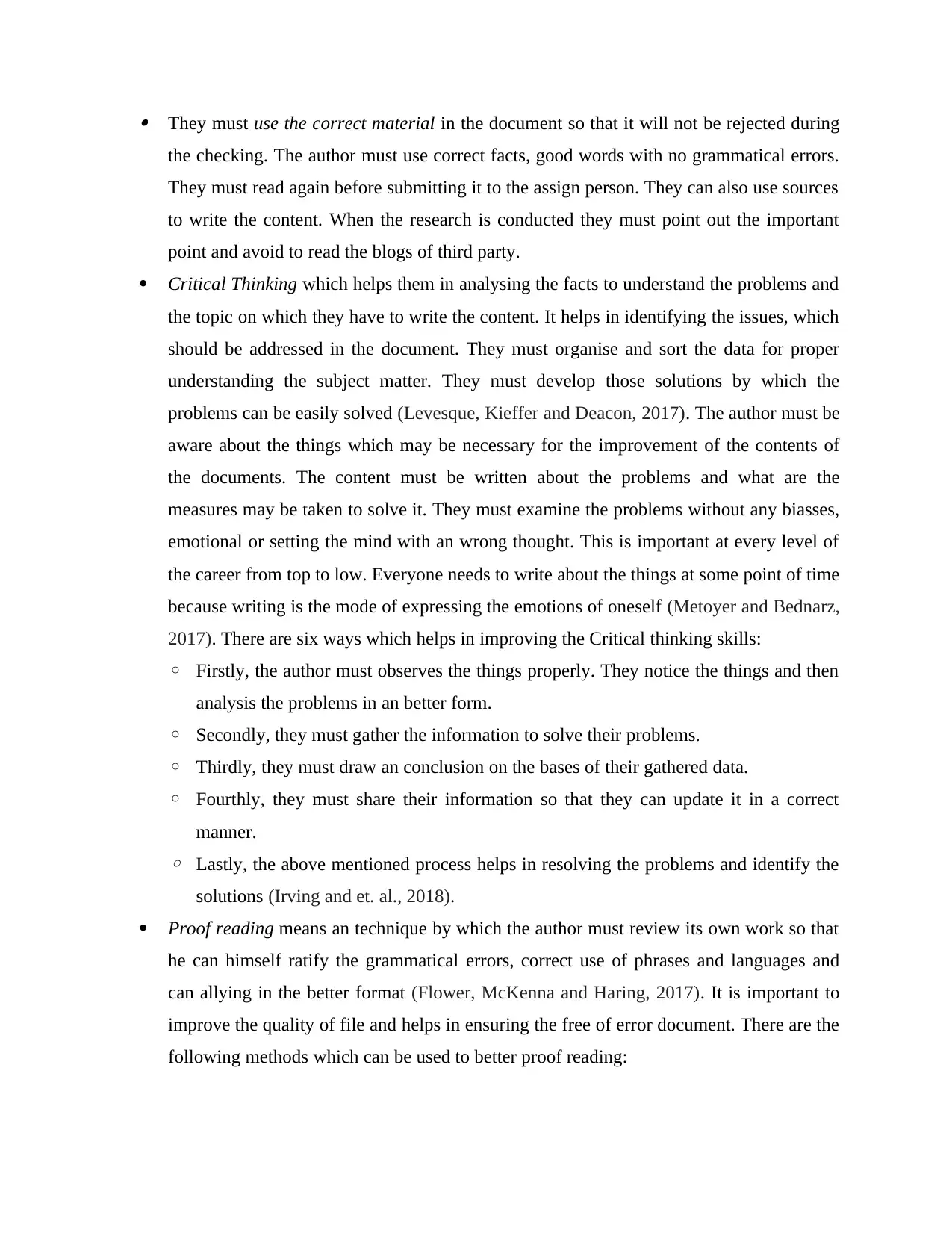
They must use the correct material in the document so that it will not be rejected during
the checking. The author must use correct facts, good words with no grammatical errors.
They must read again before submitting it to the assign person. They can also use sources
to write the content. When the research is conducted they must point out the important
point and avoid to read the blogs of third party.
Critical Thinking which helps them in analysing the facts to understand the problems and
the topic on which they have to write the content. It helps in identifying the issues, which
should be addressed in the document. They must organise and sort the data for proper
understanding the subject matter. They must develop those solutions by which the
problems can be easily solved (Levesque, Kieffer and Deacon, 2017). The author must be
aware about the things which may be necessary for the improvement of the contents of
the documents. The content must be written about the problems and what are the
measures may be taken to solve it. They must examine the problems without any biasses,
emotional or setting the mind with an wrong thought. This is important at every level of
the career from top to low. Everyone needs to write about the things at some point of time
because writing is the mode of expressing the emotions of oneself (Metoyer and Bednarz,
2017). There are six ways which helps in improving the Critical thinking skills:
◦ Firstly, the author must observes the things properly. They notice the things and then
analysis the problems in an better form.
◦ Secondly, they must gather the information to solve their problems.
◦ Thirdly, they must draw an conclusion on the bases of their gathered data.
◦ Fourthly, they must share their information so that they can update it in a correct
manner.
◦ Lastly, the above mentioned process helps in resolving the problems and identify the
solutions (Irving and et. al., 2018).
Proof reading means an technique by which the author must review its own work so that
he can himself ratify the grammatical errors, correct use of phrases and languages and
can allying in the better format (Flower, McKenna and Haring, 2017). It is important to
improve the quality of file and helps in ensuring the free of error document. There are the
following methods which can be used to better proof reading:
the checking. The author must use correct facts, good words with no grammatical errors.
They must read again before submitting it to the assign person. They can also use sources
to write the content. When the research is conducted they must point out the important
point and avoid to read the blogs of third party.
Critical Thinking which helps them in analysing the facts to understand the problems and
the topic on which they have to write the content. It helps in identifying the issues, which
should be addressed in the document. They must organise and sort the data for proper
understanding the subject matter. They must develop those solutions by which the
problems can be easily solved (Levesque, Kieffer and Deacon, 2017). The author must be
aware about the things which may be necessary for the improvement of the contents of
the documents. The content must be written about the problems and what are the
measures may be taken to solve it. They must examine the problems without any biasses,
emotional or setting the mind with an wrong thought. This is important at every level of
the career from top to low. Everyone needs to write about the things at some point of time
because writing is the mode of expressing the emotions of oneself (Metoyer and Bednarz,
2017). There are six ways which helps in improving the Critical thinking skills:
◦ Firstly, the author must observes the things properly. They notice the things and then
analysis the problems in an better form.
◦ Secondly, they must gather the information to solve their problems.
◦ Thirdly, they must draw an conclusion on the bases of their gathered data.
◦ Fourthly, they must share their information so that they can update it in a correct
manner.
◦ Lastly, the above mentioned process helps in resolving the problems and identify the
solutions (Irving and et. al., 2018).
Proof reading means an technique by which the author must review its own work so that
he can himself ratify the grammatical errors, correct use of phrases and languages and
can allying in the better format (Flower, McKenna and Haring, 2017). It is important to
improve the quality of file and helps in ensuring the free of error document. There are the
following methods which can be used to better proof reading:

◦ The author must take a step away from the document at least for 24 hours because if
it is done just after making the complete document, then it will be very difficult for
the author to detect the errors in files.
◦ It may be easy for the author to ratify the errors if it is in the physical document.
◦ The author must read the document slowly so that it can be easy for them to identify
errors and helps in ratifying it.
◦ The author must explain the important terminology so that it will be easy for the
reader to understand it. They must not explain again and again in same document.
The file must contain proper punctuations as it helps in understanding it and makes it
more representations.
◦ The author must flow the proper sequence of the document so that it will be easy to
understand it.
◦ Before submitting the file, writer should check the facts and data which was specified
in the document. This helps in submitting the accurate file (Cheng and et. al., 2017).
The author must use the correct paraphrasing and referencing so that file looks more
beautiful. It helps in understanding the main idea of the file. The subject matter of the file
helps in memorising it. It make sure that there is no sentence which is against the main
idea of the paper. While copying the matter the author must not change the literal
meaning of the terminologies, he can use its own language or may shorten the text but not
change the whole meaning. They must use best words so that it can be easily meet the
objective of writing document.
For writing the good content, the author must be aware about the things that what they
have to added and escaping from the document. They must not miss the important points
of their discourser (Jorre de St Jorre and Oliver, 2018).
The author must understand the purpose of writing it. They must understand what the
topic is all about and to answer such questions to justify it. Before staring they have to
analysis it properly.
Irrespective of the topic author must plan a structure of content of document. They can
take helps from their mentors which makes their task easier. Everyone plans a different of
their paper they can write it in the easy format or report writing.
it is done just after making the complete document, then it will be very difficult for
the author to detect the errors in files.
◦ It may be easy for the author to ratify the errors if it is in the physical document.
◦ The author must read the document slowly so that it can be easy for them to identify
errors and helps in ratifying it.
◦ The author must explain the important terminology so that it will be easy for the
reader to understand it. They must not explain again and again in same document.
The file must contain proper punctuations as it helps in understanding it and makes it
more representations.
◦ The author must flow the proper sequence of the document so that it will be easy to
understand it.
◦ Before submitting the file, writer should check the facts and data which was specified
in the document. This helps in submitting the accurate file (Cheng and et. al., 2017).
The author must use the correct paraphrasing and referencing so that file looks more
beautiful. It helps in understanding the main idea of the file. The subject matter of the file
helps in memorising it. It make sure that there is no sentence which is against the main
idea of the paper. While copying the matter the author must not change the literal
meaning of the terminologies, he can use its own language or may shorten the text but not
change the whole meaning. They must use best words so that it can be easily meet the
objective of writing document.
For writing the good content, the author must be aware about the things that what they
have to added and escaping from the document. They must not miss the important points
of their discourser (Jorre de St Jorre and Oliver, 2018).
The author must understand the purpose of writing it. They must understand what the
topic is all about and to answer such questions to justify it. Before staring they have to
analysis it properly.
Irrespective of the topic author must plan a structure of content of document. They can
take helps from their mentors which makes their task easier. Everyone plans a different of
their paper they can write it in the easy format or report writing.
⊘ This is a preview!⊘
Do you want full access?
Subscribe today to unlock all pages.

Trusted by 1+ million students worldwide
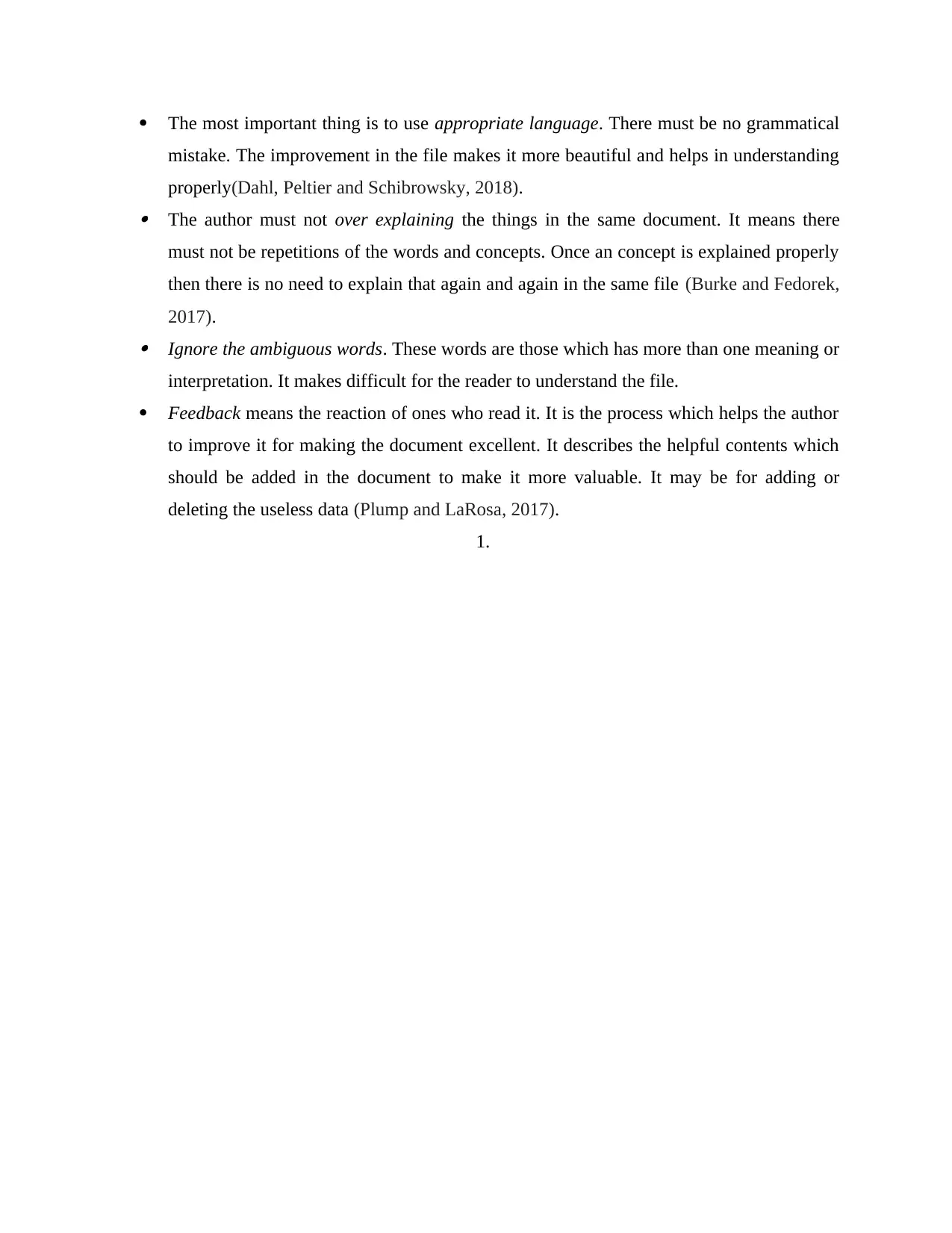
The most important thing is to use appropriate language. There must be no grammatical
mistake. The improvement in the file makes it more beautiful and helps in understanding
properly(Dahl, Peltier and Schibrowsky, 2018). The author must not over explaining the things in the same document. It means there
must not be repetitions of the words and concepts. Once an concept is explained properly
then there is no need to explain that again and again in the same file (Burke and Fedorek,
2017). Ignore the ambiguous words. These words are those which has more than one meaning or
interpretation. It makes difficult for the reader to understand the file.
Feedback means the reaction of ones who read it. It is the process which helps the author
to improve it for making the document excellent. It describes the helpful contents which
should be added in the document to make it more valuable. It may be for adding or
deleting the useless data (Plump and LaRosa, 2017).
1.
mistake. The improvement in the file makes it more beautiful and helps in understanding
properly(Dahl, Peltier and Schibrowsky, 2018). The author must not over explaining the things in the same document. It means there
must not be repetitions of the words and concepts. Once an concept is explained properly
then there is no need to explain that again and again in the same file (Burke and Fedorek,
2017). Ignore the ambiguous words. These words are those which has more than one meaning or
interpretation. It makes difficult for the reader to understand the file.
Feedback means the reaction of ones who read it. It is the process which helps the author
to improve it for making the document excellent. It describes the helpful contents which
should be added in the document to make it more valuable. It may be for adding or
deleting the useless data (Plump and LaRosa, 2017).
1.
Paraphrase This Document
Need a fresh take? Get an instant paraphrase of this document with our AI Paraphraser

CONCLUSION
With context of the above report, it can be concluded that students must develop their
reading and writing skills to get success in their life. They must follow the above mentioned
techniques to improve there reading skills which are like reading the gist of the document for
better understanding, before submitting they must read the detailed document, they must use
skimming and scanning to find out the major and important documents in the documents, they
must take the brief notes which will be helpful for them to revise the content and many other
techniques which will be helpful in developing their skills of reading. Further, this report deals
with the enhancement in the writing skills of the document for which, they have to list out the
points of feedbacks on which they have to improve their files, Critical thinking and the steps
which the students has to follows, they must phrase the data correctly and quote proper
referencing in their documents.
With context of the above report, it can be concluded that students must develop their
reading and writing skills to get success in their life. They must follow the above mentioned
techniques to improve there reading skills which are like reading the gist of the document for
better understanding, before submitting they must read the detailed document, they must use
skimming and scanning to find out the major and important documents in the documents, they
must take the brief notes which will be helpful for them to revise the content and many other
techniques which will be helpful in developing their skills of reading. Further, this report deals
with the enhancement in the writing skills of the document for which, they have to list out the
points of feedbacks on which they have to improve their files, Critical thinking and the steps
which the students has to follows, they must phrase the data correctly and quote proper
referencing in their documents.
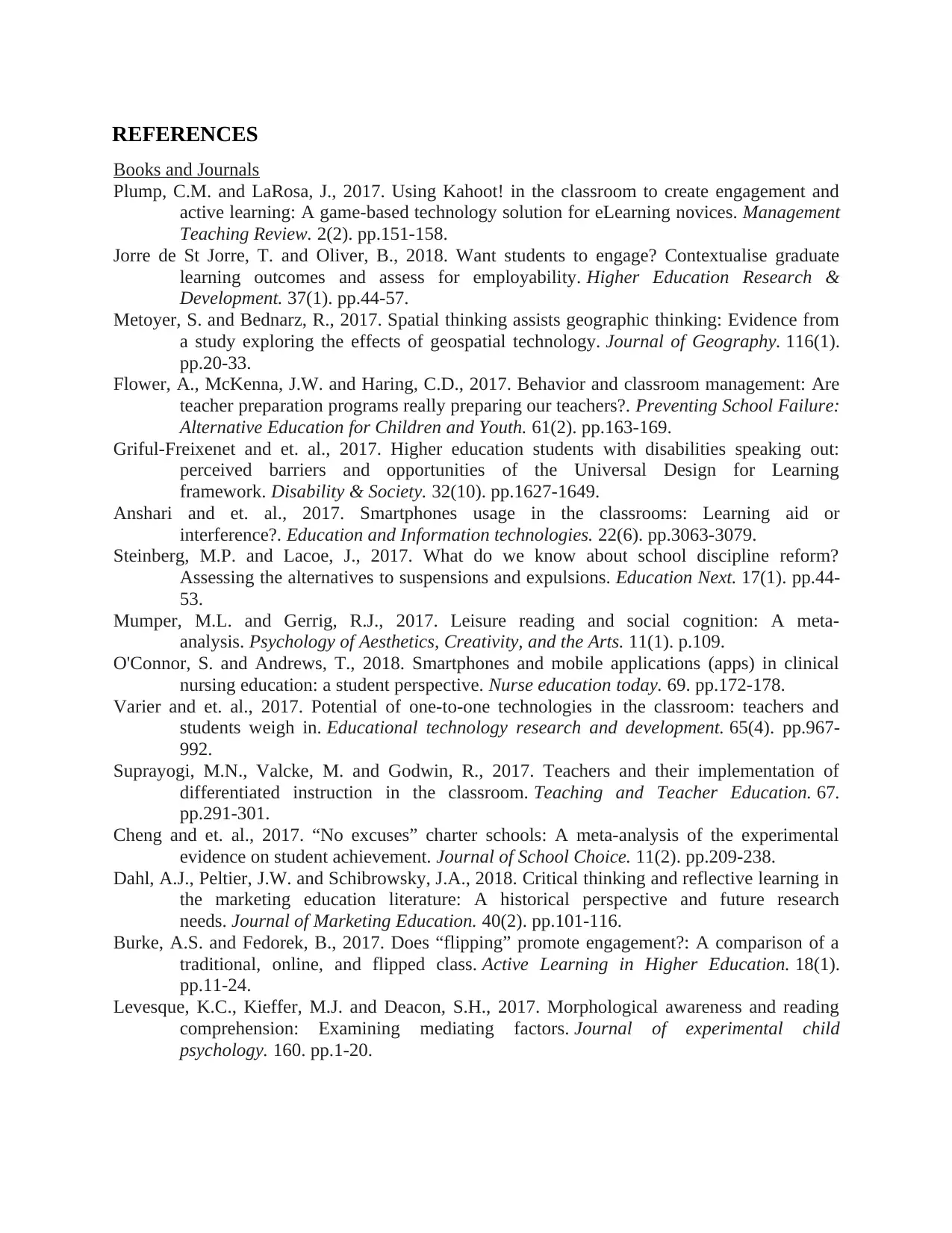
REFERENCES
Books and Journals
Plump, C.M. and LaRosa, J., 2017. Using Kahoot! in the classroom to create engagement and
active learning: A game-based technology solution for eLearning novices. Management
Teaching Review. 2(2). pp.151-158.
Jorre de St Jorre, T. and Oliver, B., 2018. Want students to engage? Contextualise graduate
learning outcomes and assess for employability. Higher Education Research &
Development. 37(1). pp.44-57.
Metoyer, S. and Bednarz, R., 2017. Spatial thinking assists geographic thinking: Evidence from
a study exploring the effects of geospatial technology. Journal of Geography. 116(1).
pp.20-33.
Flower, A., McKenna, J.W. and Haring, C.D., 2017. Behavior and classroom management: Are
teacher preparation programs really preparing our teachers?. Preventing School Failure:
Alternative Education for Children and Youth. 61(2). pp.163-169.
Griful-Freixenet and et. al., 2017. Higher education students with disabilities speaking out:
perceived barriers and opportunities of the Universal Design for Learning
framework. Disability & Society. 32(10). pp.1627-1649.
Anshari and et. al., 2017. Smartphones usage in the classrooms: Learning aid or
interference?. Education and Information technologies. 22(6). pp.3063-3079.
Steinberg, M.P. and Lacoe, J., 2017. What do we know about school discipline reform?
Assessing the alternatives to suspensions and expulsions. Education Next. 17(1). pp.44-
53.
Mumper, M.L. and Gerrig, R.J., 2017. Leisure reading and social cognition: A meta-
analysis. Psychology of Aesthetics, Creativity, and the Arts. 11(1). p.109.
O'Connor, S. and Andrews, T., 2018. Smartphones and mobile applications (apps) in clinical
nursing education: a student perspective. Nurse education today. 69. pp.172-178.
Varier and et. al., 2017. Potential of one-to-one technologies in the classroom: teachers and
students weigh in. Educational technology research and development. 65(4). pp.967-
992.
Suprayogi, M.N., Valcke, M. and Godwin, R., 2017. Teachers and their implementation of
differentiated instruction in the classroom. Teaching and Teacher Education. 67.
pp.291-301.
Cheng and et. al., 2017. “No excuses” charter schools: A meta-analysis of the experimental
evidence on student achievement. Journal of School Choice. 11(2). pp.209-238.
Dahl, A.J., Peltier, J.W. and Schibrowsky, J.A., 2018. Critical thinking and reflective learning in
the marketing education literature: A historical perspective and future research
needs. Journal of Marketing Education. 40(2). pp.101-116.
Burke, A.S. and Fedorek, B., 2017. Does “flipping” promote engagement?: A comparison of a
traditional, online, and flipped class. Active Learning in Higher Education. 18(1).
pp.11-24.
Levesque, K.C., Kieffer, M.J. and Deacon, S.H., 2017. Morphological awareness and reading
comprehension: Examining mediating factors. Journal of experimental child
psychology. 160. pp.1-20.
Books and Journals
Plump, C.M. and LaRosa, J., 2017. Using Kahoot! in the classroom to create engagement and
active learning: A game-based technology solution for eLearning novices. Management
Teaching Review. 2(2). pp.151-158.
Jorre de St Jorre, T. and Oliver, B., 2018. Want students to engage? Contextualise graduate
learning outcomes and assess for employability. Higher Education Research &
Development. 37(1). pp.44-57.
Metoyer, S. and Bednarz, R., 2017. Spatial thinking assists geographic thinking: Evidence from
a study exploring the effects of geospatial technology. Journal of Geography. 116(1).
pp.20-33.
Flower, A., McKenna, J.W. and Haring, C.D., 2017. Behavior and classroom management: Are
teacher preparation programs really preparing our teachers?. Preventing School Failure:
Alternative Education for Children and Youth. 61(2). pp.163-169.
Griful-Freixenet and et. al., 2017. Higher education students with disabilities speaking out:
perceived barriers and opportunities of the Universal Design for Learning
framework. Disability & Society. 32(10). pp.1627-1649.
Anshari and et. al., 2017. Smartphones usage in the classrooms: Learning aid or
interference?. Education and Information technologies. 22(6). pp.3063-3079.
Steinberg, M.P. and Lacoe, J., 2017. What do we know about school discipline reform?
Assessing the alternatives to suspensions and expulsions. Education Next. 17(1). pp.44-
53.
Mumper, M.L. and Gerrig, R.J., 2017. Leisure reading and social cognition: A meta-
analysis. Psychology of Aesthetics, Creativity, and the Arts. 11(1). p.109.
O'Connor, S. and Andrews, T., 2018. Smartphones and mobile applications (apps) in clinical
nursing education: a student perspective. Nurse education today. 69. pp.172-178.
Varier and et. al., 2017. Potential of one-to-one technologies in the classroom: teachers and
students weigh in. Educational technology research and development. 65(4). pp.967-
992.
Suprayogi, M.N., Valcke, M. and Godwin, R., 2017. Teachers and their implementation of
differentiated instruction in the classroom. Teaching and Teacher Education. 67.
pp.291-301.
Cheng and et. al., 2017. “No excuses” charter schools: A meta-analysis of the experimental
evidence on student achievement. Journal of School Choice. 11(2). pp.209-238.
Dahl, A.J., Peltier, J.W. and Schibrowsky, J.A., 2018. Critical thinking and reflective learning in
the marketing education literature: A historical perspective and future research
needs. Journal of Marketing Education. 40(2). pp.101-116.
Burke, A.S. and Fedorek, B., 2017. Does “flipping” promote engagement?: A comparison of a
traditional, online, and flipped class. Active Learning in Higher Education. 18(1).
pp.11-24.
Levesque, K.C., Kieffer, M.J. and Deacon, S.H., 2017. Morphological awareness and reading
comprehension: Examining mediating factors. Journal of experimental child
psychology. 160. pp.1-20.
⊘ This is a preview!⊘
Do you want full access?
Subscribe today to unlock all pages.

Trusted by 1+ million students worldwide

Yilmaz, R.M., Kucuk, S. and Goktas, Y., 2017. Are augmented reality picture books magic or
real for preschool children aged five to six?. British Journal of Educational
Technology. 48(3). pp.824-841.
Shawer, S.F., 2017. Teacher-driven curriculum development at the classroom level: Implications
for curriculum, pedagogy and teacher training. Teaching and Teacher Education. 63.
pp.296-313.
Irving and et. al., 2018. Using teledentistry in clinical practice as an enabler to improve access to
clinical care: A qualitative systematic review. Journal of telemedicine and
telecare. 24(3). pp.129-146.
real for preschool children aged five to six?. British Journal of Educational
Technology. 48(3). pp.824-841.
Shawer, S.F., 2017. Teacher-driven curriculum development at the classroom level: Implications
for curriculum, pedagogy and teacher training. Teaching and Teacher Education. 63.
pp.296-313.
Irving and et. al., 2018. Using teledentistry in clinical practice as an enabler to improve access to
clinical care: A qualitative systematic review. Journal of telemedicine and
telecare. 24(3). pp.129-146.
1 out of 10
Related Documents
Your All-in-One AI-Powered Toolkit for Academic Success.
+13062052269
info@desklib.com
Available 24*7 on WhatsApp / Email
![[object Object]](/_next/static/media/star-bottom.7253800d.svg)
Unlock your academic potential
Copyright © 2020–2025 A2Z Services. All Rights Reserved. Developed and managed by ZUCOL.





